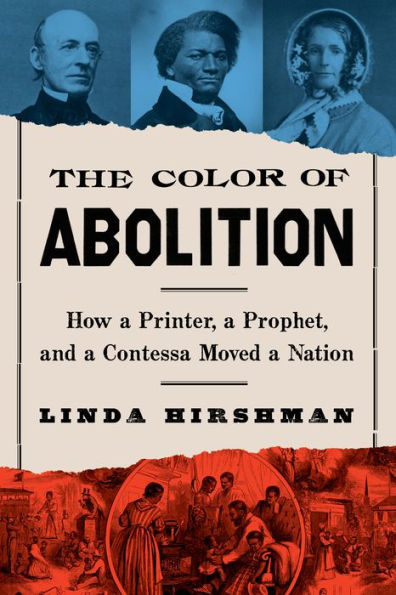"Hirshman’s book is a lively depiction of the antislavery movement, in which the three charismatic characters at the heart of her story provide an engaging avenue into the competing philosophies and strategies that continually challenged abolitionism’s unity and effectiveness. Her writing is breezy, designed to engage readers who are not historians and whose interests may lie more in the present than the past." — Washington Post
“Linda Hirshman has two goals. One is to tell the story of the American antislavery movement. This broad narrative provides background for the author’s other focus, a group portrait of three deeply intertwined abolitionists [and reflects] the author’s interest in the current ‘lively and painful conversation about the possibility and conditions of an interracial alliance.’” — Wall Street Journal
“Page-turning reading . . . . a wonderful cataloging of Americans, white and Black, who devoted their lives to ending slavery.” — Boston Globe
“By lucidly untangling the abolitionist movement’s complex web of alliances, Hirshman sheds light on the antebellum period and the dynamics of social movements in general. American history buffs will be engrossed.” — Publishers Weekly
“Hirshman brings much-needed attention to the little-known triangulation between Garrison, Douglass, and Chapman, opening a new realm of inquiry for readers of the history of slavery and abolition.” — Library Journal
“Linda Hirshman adroitly shows us that in the celebrated break up between Douglass and Garrison, a pivotal actor was Maria Weston Chapman. A brilliant but intrusive soul, Chapman stood watch over both men from a manager's desk in Boston. Beyond intrigue, though, this book provides a splendid lens into the nature of both the moral and political wings of abolitionism at their turbulent turning point. The ideologies of antislavery emerge here from vivid portraits of these three fascinating and rivalrous characters.” — David W. Blight, Yale University, and author of the Pulitzer Prize-winning Frederick Douglass: Prophet of Freedom
"A rousing account of America’s one truly great crusade, studded with fascinating characters playing for the highest of stakes: freedom.” — Megan Marshall, Pulitzer Prize-winning author of Margaret Fuller
“Viewing the abolitionist movement from a unique angle, Hirshman shows how the breakdown of the alliance among [activists Frederick Douglass, William Llloyd Garrison, and Maria Weston Chapman] was fueled in part by Douglass’ rising fame, burgeoning dissent among the nation’s political parties, and, not least, Weston Chapman’s aspersions about Douglass’ work ethic and character. A well-researched history of the fraught path to emancipation.” — Kirkus Reviews
11/29/2021
Historian and former labor lawyer Hirshman (Reckoning) focuses this informative look at the 19th-century antislavery movement on the relationship between Frederick Douglass and William Lloyd Garrison. Publisher of the abolitionist newspaper the Liberator and founder of the New England Anti-Slavery Society, Garrison and his followers called for immediate freedom for enslaved people and refused to work with any political or religious institution that didn’t reject slavery. Douglass was one of the most sought-after speakers and writers associated with Garrison’s network of antislavery societies until 1853, when he broke with the group to join the more politically focused American Anti-Slavery Society. Hirshman traces the roots of the fallout to Maria Weston Chapman, a wealthy activist who organized fund-raising bazaars and petition campaigns for Garrison and ran the Liberator in his absences. According to Hirshman, it was Weston Chapman’s “casual racism” and attempts to micromanage Douglass, coupled with his doubts about the effectiveness of Garrison’s policy of “nonpolitical nonresistance,” that led to the break, a realignment of the antislavery movement that Hirshman contends was crucial to electing Abraham Lincoln in 1860. By lucidly untangling the abolitionist movement’s complex web of alliances, Hirshman sheds light on the antebellum period and the dynamics of social movements in general. American history buffs will be engrossed. Illus. Agent: David Kuhn, Aevitas Creative Management. (Feb.)
2021-11-10
A history of a group of American abolitionists who were roiled by divisiveness.
Despite having a common interest in ending slavery, the abolition movements of mid-19th-century America were hardly unified. As cultural historian Hirshman reveals, race, gender, and class issues incited deep, discomfiting conflicts. She focuses on three central figures: William Lloyd Garrison, publisher of the influential newspaper The Liberator; rousing orator and activist Frederick Douglass; and socialite Maria Weston Chapman, who earned the epithet “The Contessa.” “Their alliance,” Hirshman discovered, “fueled critical years of the movement, and their breakup affected the direction of the movement profoundly.” Each was strong-willed and uncompromising: Garrison, whose initial connection to the anti-slavery cause came through his association with Boston Quakers, could be quarrelsome and moralistic. Weston Chapman, by virtue of her social status and wealth, expected to be obeyed. Douglass was an ambitious man who reveled in his celebrity and sought political influence. In the 1830s, the cause of abolition gained force. “From twelve white men in the basement of a Black church, through the efforts of workingmen and women, Black and white, and of dissenting ministers and argumentative college students,” Hirshman writes, “the tendrils of immediate abolitionism began to spread throughout the North.” Less than a decade after its founding in 1833, the American Anti-Slavery Society counted some 150,000 members. The Society voiced strong opposition to its rival organization, the American Colonization Society, which proposed to return Black Americans to Africa. Even within the Anti-Slavery Society, factions clashed. Some abolitionists opposed the expansion of slavery; some wanted complete abolition throughout the nation. Some, like Garrison, held that the Constitution allowed for slaveholding; Douglass vehemently disagreed. Viewing the abolitionist movement from a unique angle, Hirshman shows how the breakdown of the alliance among the three activists was fueled in part by Douglass’ rising fame, burgeoning dissent among the nation’s political parties, and, not least, Weston Chapman’s aspersions about Douglass’ work ethic and character.
A well-researched history of the fraught path to emancipation.



